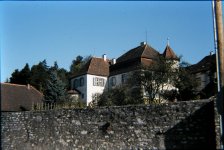
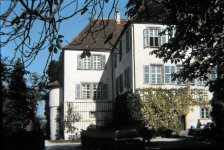
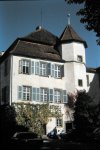
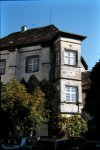
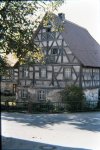
Pretzfeld 1985
     Pretzfeld 1985 |
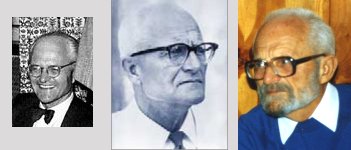
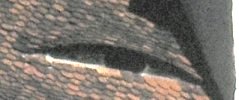 even though
they had direct access to it from their office. The tower visible in
the photo contains a
spiral staircase that is the only access to the upper floors. Therefore
equipment like diffusion furnaces had to be ordered to fit the
staircase. As they were getting bigger and bigger they had to be built
so that they could be disassembled.
even though
they had direct access to it from their office. The tower visible in
the photo contains a
spiral staircase that is the only access to the upper floors. Therefore
equipment like diffusion furnaces had to be ordered to fit the
staircase. As they were getting bigger and bigger they had to be built
so that they could be disassembled.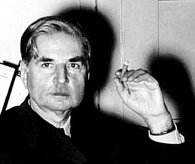 The
extension
building has an passage way through which one can reach the stables
area. The stables were the living quarters of some of the
head personnel of the first years, later on they were used as part of
the factory and now they are again transformed back to apartments.
Under the roof were some office rooms and in one of these I spent my
first half year there. Turning around to the other end of the building
there were a few
steps going up opposite of the chapel. These steps led to
the office of Walter
Schottky (the photo shows him around 1954, see also refWS1
and refWS2),
who was around quite often, but at the age of 83 was no longer involved
in the activities of the place. The office (view
from the outside) was later taken over by Spenke when he
reached his late seventies (up to that point he had his main office in
Munich) and later it became my office during the days when I stayed in
Pretzfeld.
The
extension
building has an passage way through which one can reach the stables
area. The stables were the living quarters of some of the
head personnel of the first years, later on they were used as part of
the factory and now they are again transformed back to apartments.
Under the roof were some office rooms and in one of these I spent my
first half year there. Turning around to the other end of the building
there were a few
steps going up opposite of the chapel. These steps led to
the office of Walter
Schottky (the photo shows him around 1954, see also refWS1
and refWS2),
who was around quite often, but at the age of 83 was no longer involved
in the activities of the place. The office (view
from the outside) was later taken over by Spenke when he
reached his late seventies (up to that point he had his main office in
Munich) and later it became my office during the days when I stayed in
Pretzfeld.|
Schottky is
considered to be the most ingenious German physicist who ever worked in
industry, but also one of the most difficult to understand. He was
highly paid at Siemens, but never given a leading management job.
Spenke joined Schottky in 1929 and became his 'interpreter' for the
technicians of the company and the scientific community. Spenke
probably took from Schottky the habit to dig deeply into every aspect
of a problem.
|
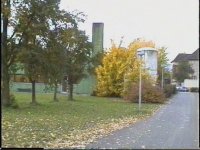 In
the early days the silicon growing (which
was later moved to Munich) was done in what were more or less barracks in the garden section.
These buildings were taken down as larger
structures were added. When the semiconductor business was
shut down some of these had to be taken out, but some of them remained
and are now used by smaller companies. The castle was renovated and
transformed for office space, but that apparently has not worked out.
In
the early days the silicon growing (which
was later moved to Munich) was done in what were more or less barracks in the garden section.
These buildings were taken down as larger
structures were added. When the semiconductor business was
shut down some of these had to be taken out, but some of them remained
and are now used by smaller companies. The castle was renovated and
transformed for office space, but that apparently has not worked out. 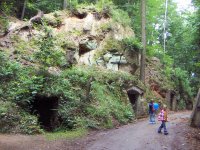 The
surroundings of Pretzfeld are the biggest cherry growing area in
Germany. So it is only normal that at the end of the cherry picking
season there has to be a cherry fest in the hills. It is a beer
festival with live music and a dance platform under the trees. These
hills are perforated with beer storing cellars of the locals. I guess
very few
people brew their own beer these days, but they still do distill their
own fruit spirits and keep them in these caverns. For some of the
people as far away as Munich the event is a good reason to travel
there, meet the old people and remember the good
old times.
The
surroundings of Pretzfeld are the biggest cherry growing area in
Germany. So it is only normal that at the end of the cherry picking
season there has to be a cherry fest in the hills. It is a beer
festival with live music and a dance platform under the trees. These
hills are perforated with beer storing cellars of the locals. I guess
very few
people brew their own beer these days, but they still do distill their
own fruit spirits and keep them in these caverns. For some of the
people as far away as Munich the event is a good reason to travel
there, meet the old people and remember the good
old times.